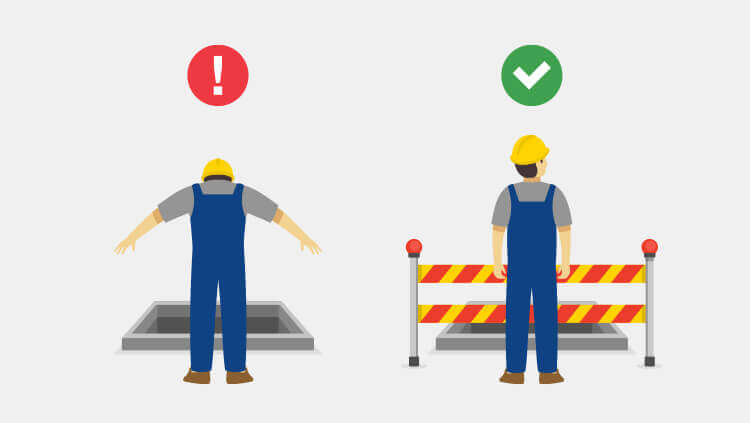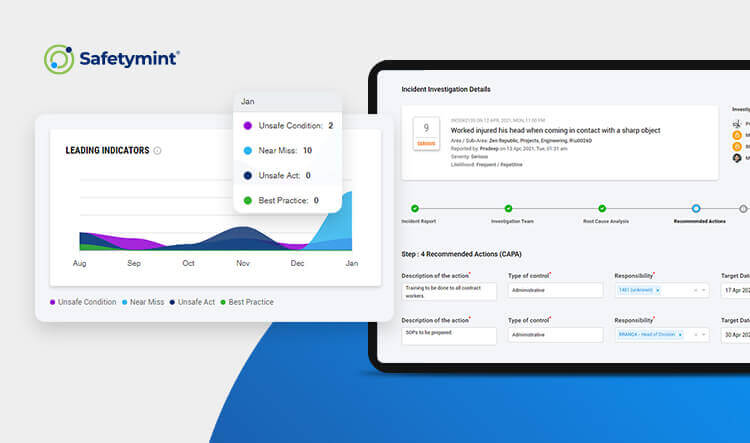Top 10 Workplace Safety Tips
Workplace safety is a critical issue that affects the health, well-being, and productivity of employees. A safe work environment is essential for protecting employees from accidents, injuries, and health hazards, and for promoting a positive and productive workplace culture.
Effective workplace safety programs and use of safety management software is hence important to help employers create and maintain a safe and healthy work environment, which can result in lower costs, increased productivity, and a better reputation for the organization.
What is workplace safety?
By definition, workplace safety refers to the measures put in place to prevent accidents and injuries in the workplace. It involves creating a safe and healthy work environment that protects employees from harm and ensures that they can perform their duties without any undue risk to their health and wellbeing.
There are several key factors that contribute to a safe and healthy work environment. Some of the most important include:
Proper training: Employees must be properly trained on how to perform their jobs safely and how to use equipment and tools correctly.
Safe equipment: All equipment and tools must be regularly maintained and checked to ensure that they are in good working order.
Adequate lighting: Proper lighting is essential for a safe and healthy work environment, especially in areas where employees are working with heavy machinery or performing tasks that require precision.
Good housekeeping: Keeping the workplace clean and organized can help prevent accidents and injuries.
Proper ventilation: Adequate ventilation is necessary to prevent the buildup of hazardous substances and to provide a comfortable and healthy work environment.
Personal protective equipment: Employees must be provided with the appropriate Personal Protective Equipment (PPE) to protect them from harm while they are performing their duties.
Emergency response plans: Employers must have emergency response plans in place to ensure that employees know what to do in case of an emergency.
Workplace injuries are surprisingly common, especially when you consider that they usually happen to people doing the same task day in and day out.
Most workplace accidents stem from unsafe working conditions, inadequately trained staff and negligence of the workers. This blog post will cover the 10 crucial workplace safety tips that you and your employees need to follow.
10 Tips to Create a Safe Workplace for Everyone
- Follow the Rules
Rules and regulations are there for a reason — to keep people safe.
If your workplace has a rule against talking on the phone while walking through a particular area or wearing additional protective gear for specific tasks, you need to follow it. By breaking the rule, you could put yourself or others in danger.
- Wear Appropriate Safety Gear
While it might seem that essential protective equipment is only necessary when working on dangerous projects, wearing safety gear is important. This is because even small accidents can cause serious injury.
If a situation arises that requires you to use any power tools, you should be wearing appropriate safety gear like steel-toed boots, hard hats, and protective eyewear like goggles or face shields. There are many other similar situations where specific jobs require wearing additional PPE than the usual helmets.
- Be Mindful of Your Surroundings
It is important to always be aware of what is going on around you at all times. This is important because distractions can cause injuries.
When you’re in an area with hazards or an ongoing job, be extra careful of the path and the things around you. It’s often best to turn off your cell phone so that you aren’t distracted by texts or calls. Also, make sure tools and machinery are not moving before you go near them and watch out for the work-in-progress signs before you step into an area.

- Use the Right Tools for the Job
If you’re using a tool created for a different type of task, you could end up with an injury. The best way to avoid injury is to use machines, tools and equipment the right way. This includes:
- Using guards and other safety devices when they’re available
- Reading and following the instructions provided by the manufacturers of the tools and equipment
- Referring to the SOPs when choosing the tools for a job.
- Put Away the Equipment After Each Use
This includes items such as extension cords, ladders and other tools. Having these items lying around can be dangerous for both you and your coworkers.
For example, tripping over an extension cord or ladder in the middle of a workday could lead to serious injuries. Laying out tools where others can’t see them could also create safety hazards since others may not realize those tools are there.
- Dress Appropriately
Proper clothing can reduce workplace injuries and help you stay comfortable at the same time. This means wearing shoes and clothing that protect you from cuts, falls and slips, especially if you work near moving machinery or sharp objects or in high-risk areas like construction sites. Remember these basic rules:
- Never wear jewelry such as rings, bracelets or neck chains when working with machinery or power tools;
- Long hair must be tied back;
- Loose clothing must be secured;
- Clothes shouldn’t drag on the floor; and
- Pant legs should be tucked into boots.
- Report Unsafe Working Conditions
If your job site is marked by broken equipment, hazardous materials or other potential dangers, report it to your employer. Also, don’t forget to report near-miss incidents as it could help your employers to create a better working space.
The Occupational Safety and Health Administration (OSHA) requires employers to maintain a safe work environment. When employees report violations of this law, OSHA can investigate and fine employers who aren’t in compliance.
- Conduct Regular Safety Audits
Regular safety audits and site inspections can unveil much more than safety violations at your workplace. It can pave way for a culture where employee safety is given utmost priority. Including the right questions in your checklists will ensure you don’t miss any violations and also attain compliance.
- Stay Sober
You may have a drink after work with friends or family or at an office party, but never drink or consume drugs before you work as it can impair you physically and mentally. You need to stay completely sober throughout the entire time you’re in the workplace to make sure that you’re completely in grips and aware of your environment.
- Keep Track of the Incidents
If you want to prevent any more injuries, you need to investigate the safety incident reports. It can be severe incidents, near-misses or accidents. Analyzing the past few months’ or year’s reports will give you a better perspective into the common issues. You can also conduct a root-cause analysis to better understand the underlying reasons for the major incidents and accidents.

You can use an online incident management system to keep complete track of all incidents and conduct quick diagnosis and trend analysis.
Also read our detailed guide on how to write an incident report.

Ramesh Nair is the Founder and Principal Partner of Safetymint, the new-age safety management software.















![Toni Kroos là ai? [ sự thật về tiểu sử đầy đủ Toni Kroos ]](https://evbn.org/wp-content/uploads/New-Project-6635-1671934592.jpg)


